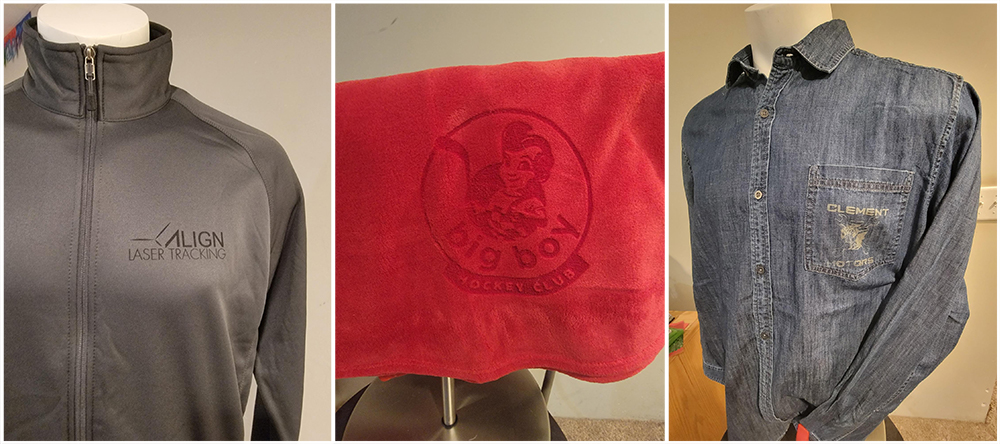As an embellisher of apparel, you’ve likely spent a lot of time adding various materials to garments as a means of decoration. What if I told you there was a decoration technique that embellishes and enhances the garment by removing from it, instead of adding to it?
What is Laser Etching?
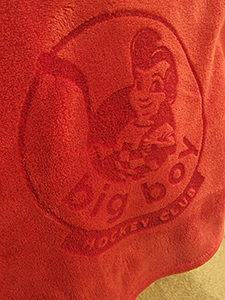 Laser etching is a process of decoration that utilizes a glass or metal tube as a laser source that burns a pattern into the top layer of fabric and leaves a classy-looking tonal image that is roughly the same color as the original fabric, but several shades darker.
Laser etching is a process of decoration that utilizes a glass or metal tube as a laser source that burns a pattern into the top layer of fabric and leaves a classy-looking tonal image that is roughly the same color as the original fabric, but several shades darker.
Laser etching is a great complementary method of decoration to add to your repertoire, as it drastically cuts out weeding time and increases the detail that can be achieved over some heat transfers. Its unique nature sets it apart from more traditional means of decoration such as embroidery and screenprinting.
Most impressively, laser etching lends itself as an excellent decoration technique to use in tandem with one of these more traditional methods of decoration. And perhaps best of all? Laser etching is a permanent decorating solution; no need to worry about it washing out, cracking, or being removed over time.
Multiple equipment options exist in this space. You can purchase stand-alone laser etching units, which are ideal for shorter runs. Some of these stand-alone units even allow for transport so you can impress your customers by decorating on-site at events. You can also invest in a full Laser Bridge to run over multiple heads of embroidery, which is a great solution for accommodating large order runs as well as achieving that mixed-media look into your design as mentioned above.
What Fabrics Can I Laser Etch On?
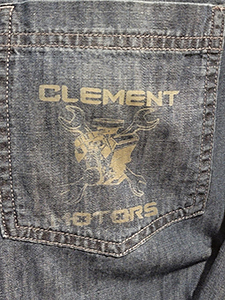 Like with all decoration techniques, it’s important that you dial in your settings and test frequently to best understand what will and won’t work when laser etching fabrics:
Like with all decoration techniques, it’s important that you dial in your settings and test frequently to best understand what will and won’t work when laser etching fabrics:
Fabrics that perform well:
- Poly Fleece
- Performance Fabrics
- Denim
- Genuine Leather
Fabrics that do not perform well:
- Cotton
- Cotton/Poly Blends
Generally, the heavier a garment’s fabric, the better the result. Since laser etching removes the top layer of fabric, it’s important to have supporting layers of fabric beneath that top layer to prevent diminishing the durability of the material.
It is also strongly advised that certain colors of fabric be tested prior to production. Most materials burn several shades darker than the original fabric, which means mid-range colored garments typically yield the best results. While you won’t have great success with black or dark navy fabrics, colors such as royal blue, kelly green, red, tan and mid-range greys perform admirably.
The precise nature of a laser beam also lends this method of decoration ideally to unique decoration locations, such as the collar, cuff, hem, or vertically down one side on the front of a full-zip fleece.
What Are Laser-Etched Leather Patches?
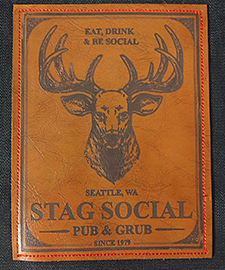 Laser etching can also be applied to other substrates, such as genuine leather patches, which have become an exceptionally popular method of decoration at both retail and in the custom apparel industry.
Laser etching can also be applied to other substrates, such as genuine leather patches, which have become an exceptionally popular method of decoration at both retail and in the custom apparel industry.
The process of laser etching on leather is very similar to clothing, however it is advised to cover the leather with a masking tape prior to etching, as this will keep the edges of the leather as clean as possible around the design. Not masking the leather could result in scorching and muddled lines.
By etching a logo onto a square piece of leather, that leather can then simply be cut by reducing the speed and increasing the wattage of the laser to outline the design or logo that has already been engraved. Once complete, simply weed the masking tape away from the leather to reveal your design. Optionally, you may want to wipe away any unwanted residue or debris or apply a leather finish upon completion. Your leather patch can then be applied to your accessory or article of clothing by way of embroidery around the perimeter of the patch, or via heat press if the patch has an adhesive backing.
Leather patches can be found on many different categories, such as headwear, bags, outerwear, fleece, aprons, and blankets. They provide a timeless, rustic look virtually unmatched by other methods of decoration.
Getting Into the Specifics
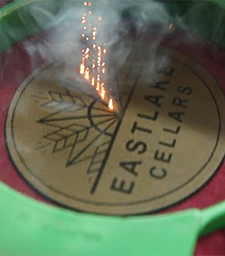 At its most rudimentary of principles, laser etching all comes down to wattage and speed. Precision and pulse rate are directly related, which means the higher the pulse rate is, the more precise the beam will be. To deliver this laser to the fabric, the source materials on present-day equipment are often categorized into two spaces; a water-cooled glass tube, or an air-cooled metal tube.
At its most rudimentary of principles, laser etching all comes down to wattage and speed. Precision and pulse rate are directly related, which means the higher the pulse rate is, the more precise the beam will be. To deliver this laser to the fabric, the source materials on present-day equipment are often categorized into two spaces; a water-cooled glass tube, or an air-cooled metal tube.
The fundamental differences between these two laser sources are as follows:
Water-Cooled Glass Tubes
- Low entry price point for physical material
- Laser is produced by exciting gas with direct current, which is an inexpensive process
- Pulses from glass tubes are less frequent, and tend to create a lower quality engraving than their metal tube counterparts
- Water cooling system increases cost due to footprint, and introduces more points of failure that need to be accounted for
Air-Cooled Metal Tubes
- Higher in cost compared to their glass tube counterparts
- Laser is produced by exciting gas with radio frequency alternating current
- Regulating temperatures only require the use of fans, which reduces spatial footprint and removes the need for additional equipment or maintenance
- Higher cost of metal tubes come with more peace of mind regarding performance, durability, safety, and size
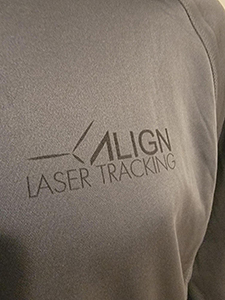 Lastly, like with all other decoration techniques, there are a variety of software programs that can be utilized with this method of decoration. Here’s a list of some of the more commonly used software types in conjunction with laser systems:
Lastly, like with all other decoration techniques, there are a variety of software programs that can be utilized with this method of decoration. Here’s a list of some of the more commonly used software types in conjunction with laser systems:
- Text Software
- Graphic Design and Layout Software
- Photo Editing Software
- Computer Aided Design/Engineering Design Software
- Serialization and Coding Software
While we could certainly get into the heavy details about ideal settings for different fabrics, those conversations are best left to be had with your equipment supplier. Different materials produce different results, and are largely dependent on your tube source and brand of equipment.
For more information about this exciting technique, take a look at our videos on SanMar U. We have a laser etching overview that covers many of the basics, as well as more detailed videos about troubleshooting wattage and speed and how to use laser etching to cut leather and appliqué.
In Conclusion
With the vast landscape of decoration always evolving to accommodate new and unique techniques, laser etching has proven itself to be one of the stalwart methods of decoration that is here to stay. As you continue to research laser etching, you may very well find room to implement it into your shop or home-based business before you know it. Just remember, lean towards heavier fabrics, select mid-range color palettes, and always test-etch your fabric prior to production.
